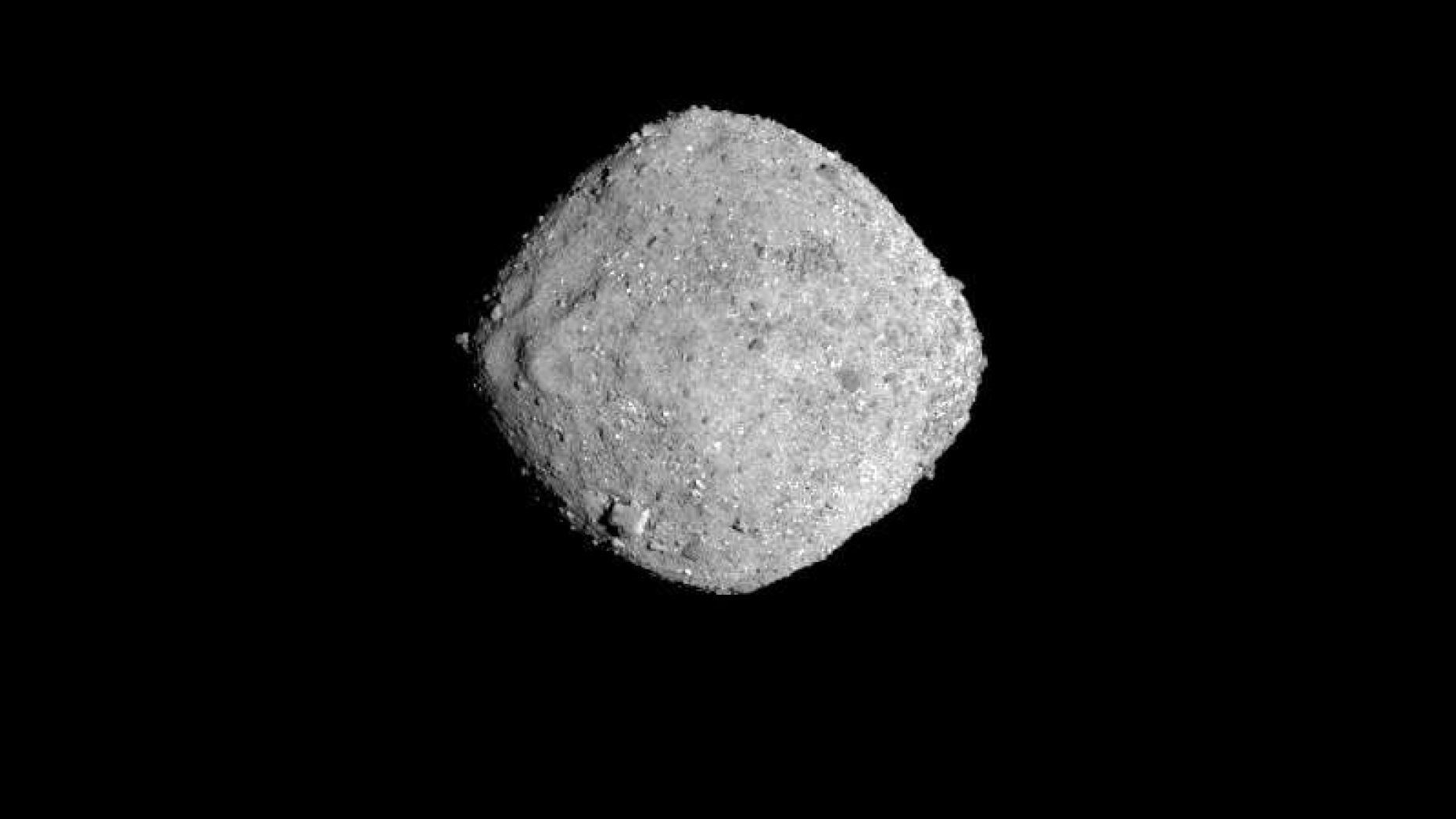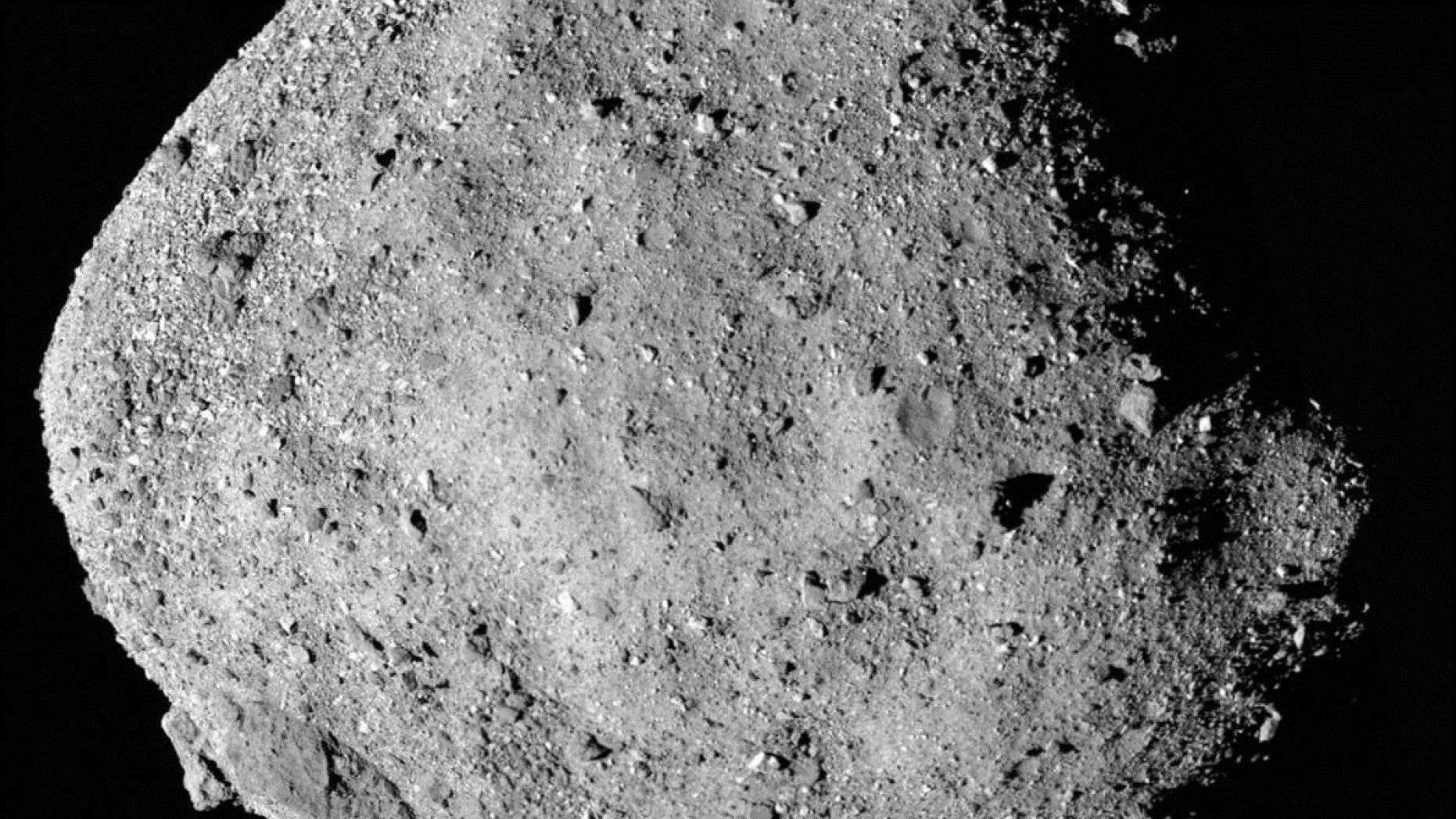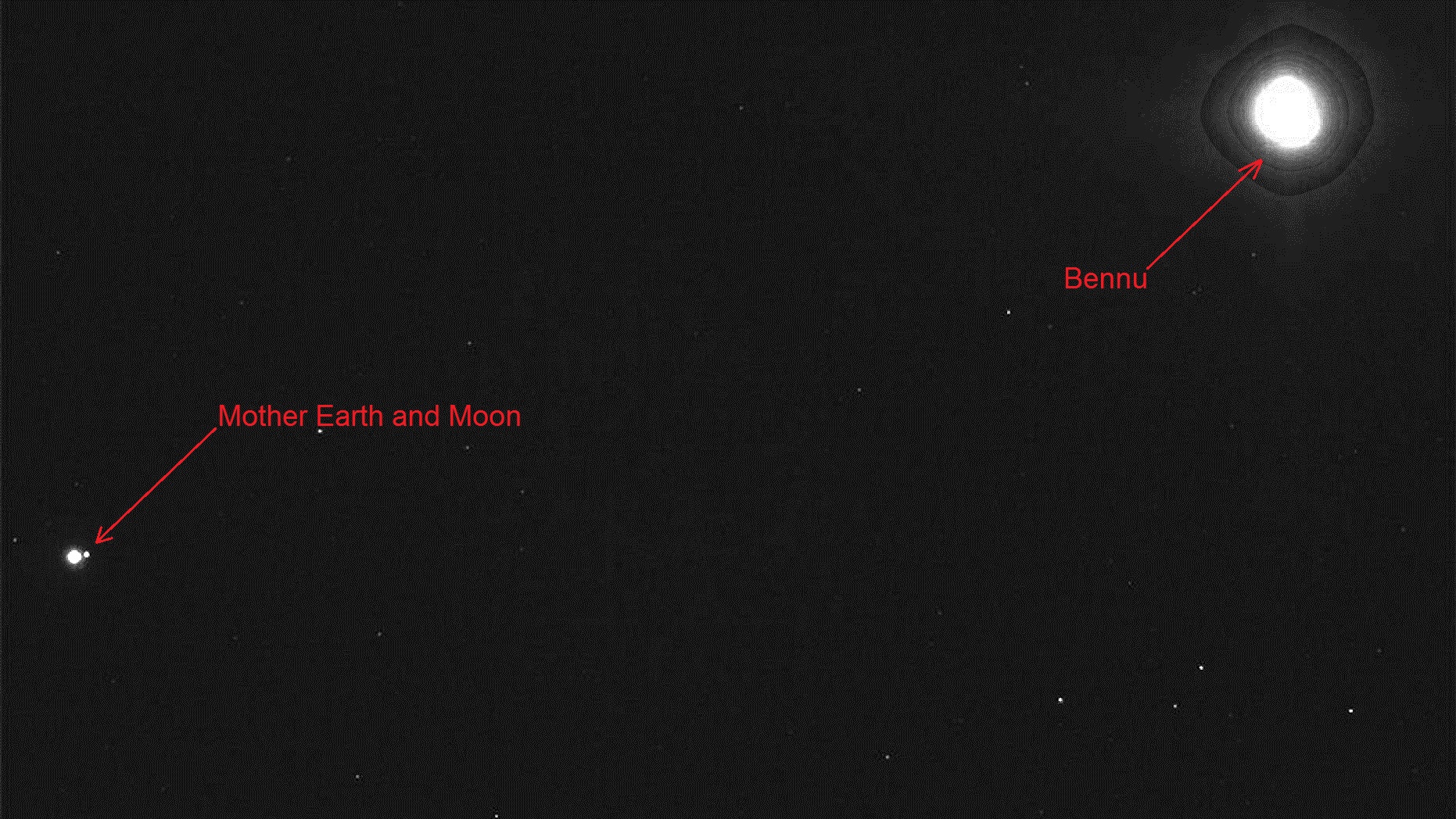It looks like you're using an Ad Blocker.
Please white-list or disable AboveTopSecret.com in your ad-blocking tool.
Thank you.
Some features of ATS will be disabled while you continue to use an ad-blocker.
share:
NASA’s probe, OSIRIS-REx, is now orbiting the tiny asteroid, Bennu, from a mile out. The probe launched in September 2016 and traveled 1 billion
miles through space to reach Bennu. It was sent to this tiny asteroid, roughly one-third of a mile across, because it may provide answers to the
origin of our solar system.
Bennu At A Distance Of 85 Miles:

Two spectrometers on OSIRIS-REx, discovered the presence of “hydroxyls” molecules on Bennu.
www.foxnews.com...
A Close Up Of Bennu:

www.foxnews.com...
The image below "was captured on Dec. 19, 2018, by a camera on the Osiris-Rex spacecraft shows the asteroid Bennu, top right, about 27 miles from the spacecraft, and the Earth and moon, bottom left, more than 70 million miles away." (NASA/Goddard/University of Arizona/Lockheed Martin Space via AP)

Bennu At A Distance Of 85 Miles:

Two spectrometers on OSIRIS-REx, discovered the presence of “hydroxyls” molecules on Bennu.
“While Bennu itself is too small to have ever hosted liquid water, the finding does indicate that liquid water was present at some time on Bennu’s parent body, a much larger asteroid,” said NASA in a statement.
www.foxnews.com...
A Close Up Of Bennu:

The spacecraft will spend almost a year surveying the space rock from orbit. The probe is scheduled to briefly touch the asteroid with a robotic arm in July 2020 and retrieve a sample that will be returned to Earth in September 2023.
www.foxnews.com...
The image below "was captured on Dec. 19, 2018, by a camera on the Osiris-Rex spacecraft shows the asteroid Bennu, top right, about 27 miles from the spacecraft, and the Earth and moon, bottom left, more than 70 million miles away." (NASA/Goddard/University of Arizona/Lockheed Martin Space via AP)

a reply to: shawmanfromny
Incredible image, I could stair at that and ponder for a while that’s for sure
Incredible image, I could stair at that and ponder for a while that’s for sure
I wouldn’t have ever guessed our moon looking that big from out there.
So questions...
Why does it look that big? Because it’s closer to the camera?
Why doesn’t moons around other planets look so much smaller? Is it because the size ratio compared to us?
So questions...
Why does it look that big? Because it’s closer to the camera?
Why doesn’t moons around other planets look so much smaller? Is it because the size ratio compared to us?
a reply to: TexasTruth
Shrinkage!!
Btw, looks really close too! All the other moons look like orbit distance but the moon looks like a tick about to land!
Shrinkage!!
Btw, looks really close too! All the other moons look like orbit distance but the moon looks like a tick about to land!
a reply to: TexasTruth
The Moon looks so close to the Earth because the Earth-Moon system is rotating so we are catching the system when the Moon would be close to being occulted by the Earth, or just coming out of occultation, in respect to being viewed from near where that comet/asteroid is.
The Moon looks so close to the Earth because the Earth-Moon system is rotating so we are catching the system when the Moon would be close to being occulted by the Earth, or just coming out of occultation, in respect to being viewed from near where that comet/asteroid is.
edit on 8-1-2019
by charlyv because: spelling , where caught
edit on 8-1-2019 by charlyv because: (no reason given)
That's about the "friendliest" looking asteroid I've seen in any photos. It looks like a crew could land, throw rocks into space, see how high one
could jump.....have fun.
On a more serious note, why do so many mission statements say Scientists are hoping to find "the origins of our solar system"?
I thought it was understood that the galactic disk cooled and stars/planets formed. Millions of them. There's no mystery to solve regarding OUR solar system, since it was created from the same material as everything else. Right?
On a more serious note, why do so many mission statements say Scientists are hoping to find "the origins of our solar system"?
I thought it was understood that the galactic disk cooled and stars/planets formed. Millions of them. There's no mystery to solve regarding OUR solar system, since it was created from the same material as everything else. Right?
originally posted by: carewemust
That's about the "friendliest" looking asteroid I've seen in any photos. It looks like a crew could land, throw rocks into space, see how high one could jump.....have fun.
On a more serious note, why do so many mission statements say Scientists are hoping to find "the origins of our solar system"?
I thought it was understood that the galactic disk cooled and stars/planets formed. Millions of them. There's no mystery to solve regarding OUR solar system, since it was created from the same material as everything else. Right?
It's only a hypothesis, and science thrives on confirmation, no matter how "obvious" something is. The more it gets confirmed, the better.
originally posted by: charlyv
a reply to: TexasTruth
The Moon looks so close to the Earth because the Earth-Moon system is rotating so we are catching the system when the Moon would be close to being occulted by the Earth, or just coming out of occultation, in respect to being viewed from near where that comet/asteroid is.
I agree with everything here, however. Isn't it a mystery why our moon is so abnormally large in relation to our planet?
I think the collision theory is nonsense. Our moon just doesn't appear to be natural. It appears to be designed. It's too perfect...
edit on
912019 by Wide-Eyes because: Missed word
originally posted by: TexasTruth
I wouldn’t have ever guessed our moon looking that big from out there.
So questions...
Why does it look that big? Because it’s closer to the camera?
I'd say the Moon looks blown out due to long exposure. With a shorter exposure, it would be just a pixel.
originally posted by: wildespace
originally posted by: carewemust
That's about the "friendliest" looking asteroid I've seen in any photos. It looks like a crew could land, throw rocks into space, see how high one could jump.....have fun.
On a more serious note, why do so many mission statements say Scientists are hoping to find "the origins of our solar system"?
I thought it was understood that the galactic disk cooled and stars/planets formed. Millions of them. There's no mystery to solve regarding OUR solar system, since it was created from the same material as everything else. Right?
It's only a hypothesis, and science thrives on confirmation, no matter how "obvious" something is. The more it gets confirmed, the better.
I guess the best way to "confirm the origin of the solar system" is to analyze material from outside our solar system and compare it to what we have here. We'll probably find the same materials in almost all of them, within the Milky Way galaxy.
The variety of life is probably far more exciting than rocks, water, methane, etc..
a reply to: wildespace
Aye id have to think this is why , the luminosity build up from long exposure
Aye id have to think this is why , the luminosity build up from long exposure
I think the biggest takeaway from this picture is how close the moon really is to earth. And yet that is the furthest a man has ever been from the
planet.
a reply to: Wide-Eyes
I agree with you on the moon being suspect. Just to many factors that really are hard to fathom all of them occurring on one rock rotating around a planet. It has always seemed to big to me like it should just be flung away from earth once it goes around.
I agree with you on the moon being suspect. Just to many factors that really are hard to fathom all of them occurring on one rock rotating around a planet. It has always seemed to big to me like it should just be flung away from earth once it goes around.
a reply to: Wide-Eyes
Most certainly, none of us would be here if it were not for the perfection of the Moon. We are a result of it's perfection.
As such, it invokes a rule of the uncertainty principle - "If the world was not the way it is, we would not be here to observe it."
It is the cover story for all mysteries.
Addend: The Moon is responsible for the ocean tides, which in turn caused all of the beaches in the world. The beaches provided the crossover point from marine to land animals, in that sense.
I think the collision theory is nonsense. Our moon just doesn't appear to be natural. It appears to be designed. It's too perfect...
Most certainly, none of us would be here if it were not for the perfection of the Moon. We are a result of it's perfection.
As such, it invokes a rule of the uncertainty principle - "If the world was not the way it is, we would not be here to observe it."
It is the cover story for all mysteries.
edit on 9-1-2019 by charlyv because: c
Addend: The Moon is responsible for the ocean tides, which in turn caused all of the beaches in the world. The beaches provided the crossover point from marine to land animals, in that sense.
edit on 9-1-2019 by charlyv because: (no reason given)
originally posted by: dragonridr
I think the biggest takeaway from this picture is how close the moon really is to earth. And yet that is the furthest a man has ever been from the planet.
Our 50 years of space travel is analogous to how far a snail travels in 50 milliseconds. When I was a kid, the potential of man landing on Mars was a big deal in my mind. But now I realize how many billions of solar systems are out there to explore, yet we can't even explore 1 of them. Maybe our great, great grand-children?
originally posted by: charlyv
a reply to: Wide-Eyes
Addend: The Moon is responsible for the ocean tides, which in turn caused all of the beaches in the world. The beaches provided the crossover point from marine to land animals, in that sense.
Are you saying that without the Moon, there would be no beaches?
Or did you mean intertidal zones in particular?
Because a beach is just where a body of water meets dry land, Moon or no.
Without the Moon, we would still have tides, from the Sun, but of course weaker than the tides we have from the Moon. The Earth would be also spinning much faster that it does now, causing a shorter day-night cycle. That would present its own challenges for appearance and evolution of life, but I wouldn't say life would be impossible without the Moon.
edit on 10-1-2019 by wildespace because: (no reason given)
originally posted by: wmd_2008
originally posted by: AtlasHawk
At least we see some stars in some of these images finally.
Not this BS again, yes you see the stars and guess what the other objects are over exposed because of that.
And even with that overexposure, look how many millions and millions of stars we can see!
As an illustration of other points made about why the moon looks so close to the EArth, here's a view from Celestia. The are both from the same date and I've zoomed out far enough to try and make Earth and moon roughly the same size as can be seen in the photograph.

On the left the moon is very close, on the right it's much further away on the edge of the image, and the difference is entirely down to the viewing angle.
edit on 10/1/2019 by OneBigMonkeyToo because: (no reason given)
a reply to: wildespace
Tides would be miniscule without the Moon. The tides produce the beaches by grinding up and spreading particulate rocks, silica and coral that provided the mechanism and environment for life to emerge from the sea and gain a foothold on land.
Tides would be miniscule without the Moon. The tides produce the beaches by grinding up and spreading particulate rocks, silica and coral that provided the mechanism and environment for life to emerge from the sea and gain a foothold on land.
new topics
-
DOJ Special Counsel Robert HUR Says JOE BIDEN Can Be ARRESTED After Jan 20th 2025.
Above Politics: 1 hours ago -
More Proof of Lawfare
US Political Madness: 8 hours ago -
I thought Trump was the existential threat?
World War Three: 9 hours ago -
Interesting Video-UFO?
Aliens and UFOs: 10 hours ago -
Joe Biden Dabs Away Tears at Farewell White House Dinner
Politicians & People: 10 hours ago
top topics
-
I thought Trump was the existential threat?
World War Three: 9 hours ago, 19 flags -
More Proof of Lawfare
US Political Madness: 8 hours ago, 18 flags -
Joe Biden Dabs Away Tears at Farewell White House Dinner
Politicians & People: 10 hours ago, 9 flags -
Interesting Video-UFO?
Aliens and UFOs: 10 hours ago, 6 flags -
DOJ Special Counsel Robert HUR Says JOE BIDEN Can Be ARRESTED After Jan 20th 2025.
Above Politics: 1 hours ago, 4 flags
active topics
-
Merry-Go-Round Ride
Short Stories • 9 • : randomuser2034 -
I thought Trump was the existential threat?
World War Three • 49 • : tamusan -
More Proof of Lawfare
US Political Madness • 26 • : ElitePlebeian2 -
DOJ Special Counsel Robert HUR Says JOE BIDEN Can Be ARRESTED After Jan 20th 2025.
Above Politics • 6 • : WeMustCare -
Joe Biden Dabs Away Tears at Farewell White House Dinner
Politicians & People • 23 • : xuenchen -
On Nov. 5th 2024 - AMERICANS Prevented the Complete Destruction of America from Within.
2024 Elections • 159 • : WeMustCare -
What if this is true?
2024 Elections • 30 • : chr0naut -
Petition Calling for General Election at 564,016 and rising Fast
Political Issues • 88 • : Freeborn -
Well, here we go red lines crossed Biden gives the go ahead to use long range missiles
World War Three • 360 • : Freeborn -
Encouraging News Media to be MAGA-PAF Should Be a Top Priority for Trump Admin 2025-2029.
Education and Media • 79 • : DBCowboy
